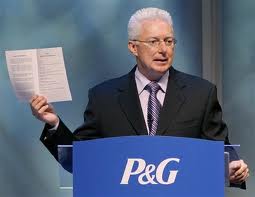Strategy: Five Components
A.G Lafley is justifiably famous for taking over Procter & Gamble (P&G) and converting an insular company into a customer-centric, outward-looking culture known for a string of successful innovations. When Lafley became CEO in 2000, innovation was driven by thousands of in-house R&D designers, researchers, and engineers. They created neat stuff and “pushed” it to customers. Partially as a result, P&G’s success rate with new products and brands hovered around 15%. The R&D teams focused internally; only about 10% of new products came from outside the company.
Lafley essentially turned the company inside-out by putting the customer at the head of the innovation process. P&G called it Connect + Develop and emphasized collaboration with other departments, customers, and even outside research organizations. Lafley changed the culture from “not invented here” to “proudly found elsewhere”. P&G signed more than 1,000 collaborative agreements with outside organizations. It was a fundamental cultural change and the results were spectacular. According to a report from A.T. Kearney, “During Lafley’s tenure, sales doubled, profits quadrupled, and the company’s market value increased by more than $100 billion”.
Now Lafley has written a book, Playing to Win: How Strategy Really Works, with Roger Martin, the Dean of the Rotman School of Management at the Univeristy of Toronto. Martin was Lafley’s “principal external strategy advisor”. In addition to Martin, Lafley built a brain trust of outside thinkers including designers and business professors. The eclectic nature of the group created many different “idea collisions” that generated process innovations as well as product innovations.
I’m sure that I’ll write a lot about the book in the future but it’s not quite out yet. It debuts in February. Today, I’m depending on the report from A.T. Kearney and a lengthy review from The Economist. One of the key insights is that P&G followed a strategy composed of five elements, each designed to help managers make the right decisions. These are:
- What does winning look like? What are we aiming for and what information do we look for along the way to help us understand if we’re making progress? Do we seek global domination, regional, or local?
- Which markets should we play in? Of course, this also implies another question: which markets should we ignore (or exit)? How do we determine which is which?
- How do we win? What’s our distinctive strategy in each market and category?
- What are our strengths and weaknesses and how do we deploy them in each market, against each competitor?
- What needs to be managed for the strategy to succeed? Of course, the inverse of this question is what doesn’t need to be managed? The Economist reports that one of Lafley’s “most important innovations was a slimmed-down strategy-review process … [that] replaced needlessly sprawling bureaucratic meetings….”
It’s a good story and an intriguing look at strategy. Unfortunately, it doesn’t have an entirely happy ending. The Economist reports that P&G has “stumbled badly” since Lafley left in 2009. Similarly, Martin’s consulting firm “got into financial difficulty and has been sold at a discount.” Still, the questions are relevant to any company’s strategy and the story is intriguing. I’ll report more soon.
Innovation: Five Trends

Good ideas. How do we integrate them?
We know a lot about what innovation looked like in the past. What does it look like in the future?
That’s the question that Arthur D. Little (ADL) researchers asked of more than 100 Chief Technical Officers and Chief Innovation Officers in a recently published white paper. (Click here). The ADL researchers identified five key trends that should drive innovation management over the next decade. Today, I’ll summarize the trends. In the future, I’ll to delve into each one in more detail.
The most important trend — as rated by the CIOs and CTOs –is customer-based innovation — “finding new and more profound ways to engage with customers and develop deeper relationships with them.” B2B companies have traditionally emphasized customer-based innovation. After all, B2B companies have relatively few but relatively deep customers relationships. According to ADL, however, even B2C companies are now focusing less on the product itself and more on the “ownership experience”.
The second trend is proactive business process innovation. I read widely on innovation and almost everything I see has to do with product innovation. ADL says this is changing but that “there is still much to be done to develop a convincing innovation management approach that is sufficiently systematic and repeatable to generate new, innovative business models.” The first objective is to deliver “thick value” — long-term relationships with multiple touch points as opposed to “thin value” transactions.
Third is frugal innovation which may be better known as reverse innovation. Rather than innovating in high-value (and high-cost) knowledge economies, frugal innovation uses low-cost emerging economies to create products with “less” rather than “more”. Developing a new idea in India, say, will often result in a lower cost product than developing the same idea in Europe. Frugal innovation often changes entire supply chains rather than individual products.
Fourth is high speed/low risk innovation. The CIOs and CTOs say they expect even more time-to-market pressure in the next decade. Additionally, they think that product life cycles will continue to accelerate. At the same time,the customer’s ability to identify and publicize flawed products has expanded dramatically. So, even as the pressure to accelerate continues, the pressure to deliver flawless products also increases. How do you deliver high quality products in ever faster cycles? You change your business process. ADL expects to see more gradual product rollouts coupled with more pervasive and proactive post-sales service.
Integrated innovation is the last major trend ADL identifies. The idea here is to take innovation processes out of the New Product Development (NPD) domain and integrate them into all business processes and strategies. Among other things, this requires collaboration across traditional functional divisions. Organizational development experts will focus on building horizontal layers to replace vertical silos. Creating an Enterprise Architecture (EA) to manage knowledge and information could drive this trend.
So, five trends in innovation management – each is interesting in and of itself. Over the next few weeks, I’ll delve into each one in more detail and identify the prerequisites for success in each one. Stay tuned.
